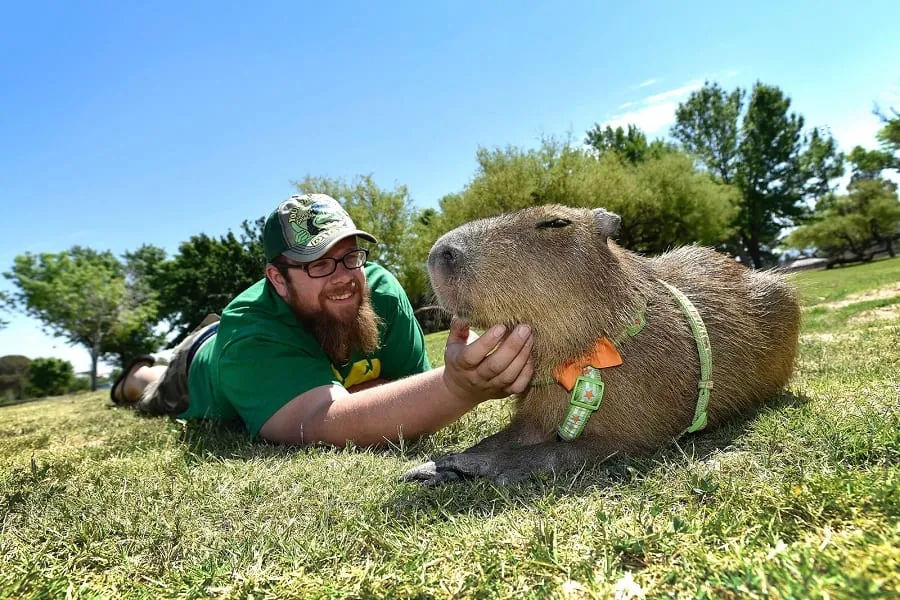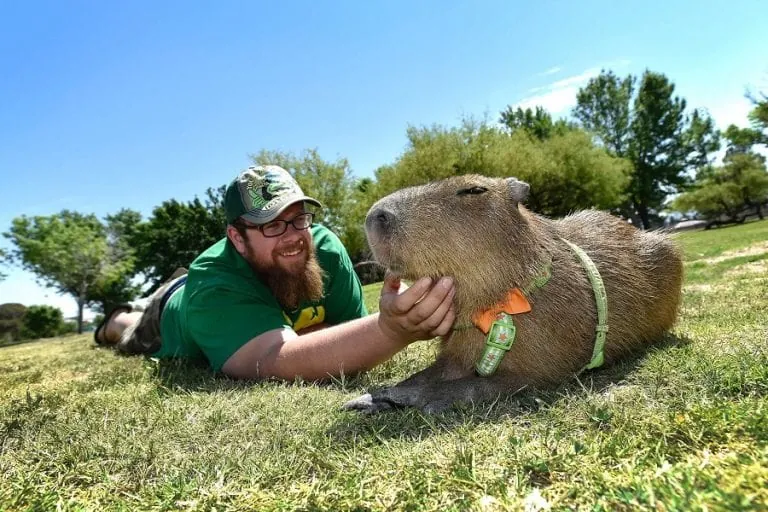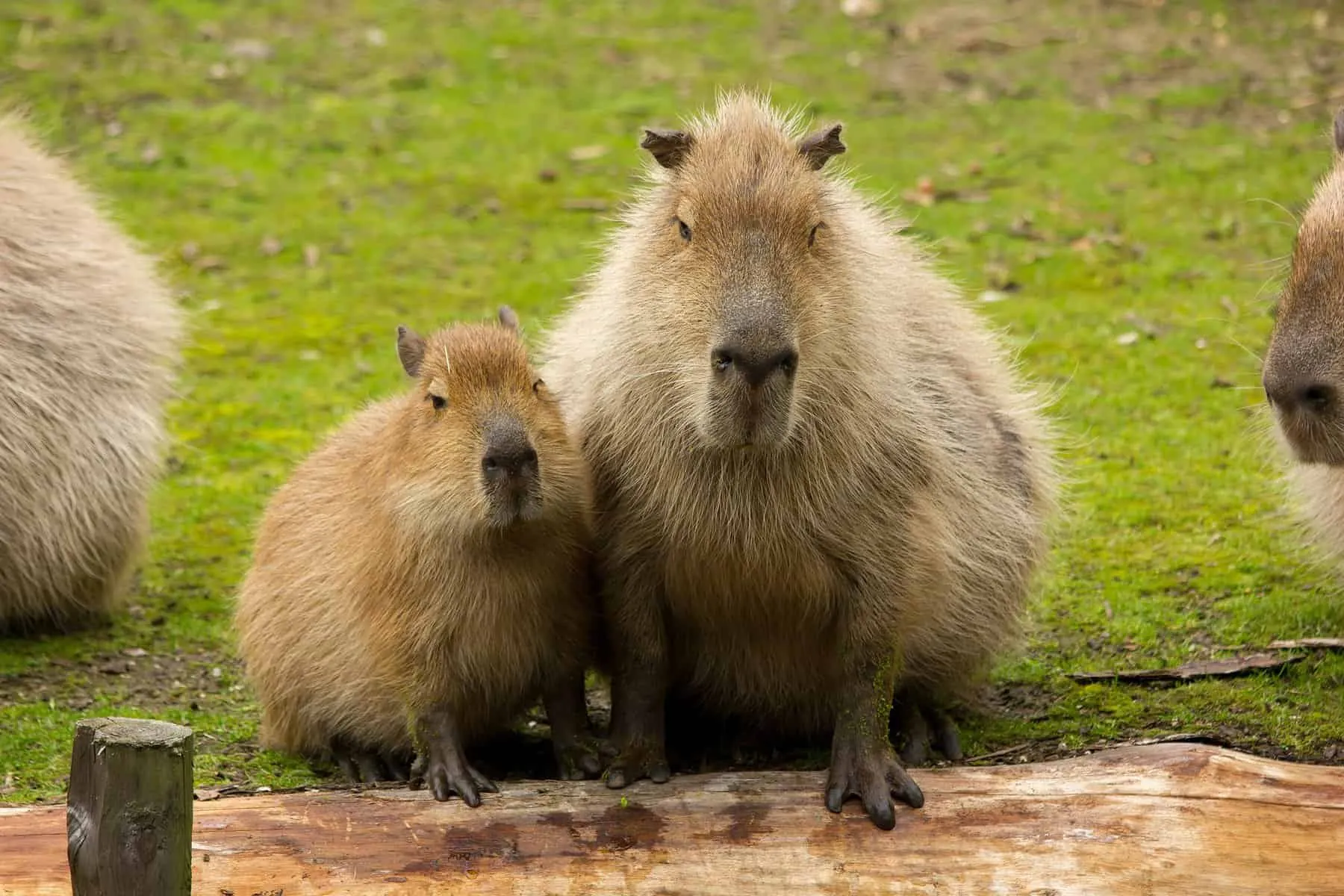Let’s cut to the chase—are capybaras good pets? You’ve probably seen these chill giants swimming in pools, hanging out with ducks, and melting the internet with their zen vibes. But are they really the perfect pet for you? That’s a fair question because owning a capybara isn’t like getting a cat or a dog. They’re unique, and with that comes a unique set of challenges and rewards.
In this guide, I’ll walk you through everything: their temperament, living needs, the pros and cons, and some questions you didn’t even know to ask. Let’s dive in!
What Is a Capybara?

Capybaras are the largest rodents in the world, native to South America. Think of them as giant guinea pigs with webbed feet and an intense love for water. They can grow up to 4 feet long and weigh 100–170 pounds. That’s no small pet!
In the wild, capybaras thrive in groups near water, grazing on grasses and aquatic plants. Their semi-aquatic nature means they’re built for swimming, complete with webbed toes and waterproof fur.
But here’s the thing: just because they look like chill little river potatoes doesn’t mean they’re easy pets. They need specific care and attention to live happily outside their natural habitat.
Pros of Owning a Capybara
Let’s start with the good stuff because, honestly, these animals can be amazing in the right setting.
1. They’re Incredibly Social
Capybaras are like the extroverts of the animal kingdom. They love hanging out—whether it’s with other capybaras, your dog, or even you. If you have the space and time to meet their social needs, they can become loyal and affectionate companions.
2. They’re Gentle Giants
Despite their size, capybaras are calm and non-aggressive. With proper socialization, they can even become comfortable being handled. That laid-back attitude is a big part of their appeal.
3. Low Allergens
Capybaras don’t shed much and don’t have a strong odor, so they’re easier on your allergies compared to cats or dogs.
4. They Get Along With Other Animals
Do you already have pets? Capybaras are known to befriend other animals, from chickens to dogs. That said, introductions should always be slow and supervised.
Cons of Owning a Capybara
Now for the other side of the coin—capybaras can be difficult to care for. Here’s what you need to know:
1. They Need Space—A Lot of It
This isn’t an apartment-friendly pet. Capybaras need outdoor enclosures of at least 12 x 20 feet for a pair, with a swimming pool or pond because they’re semi-aquatic. Without access to water, they’ll be stressed and unhealthy.
2. They’re Not Lone Rangers
Capybaras hate being alone. Keeping just one can lead to depression and destructive behavior. You’ll need at least two, and that doubles your care responsibilities.
3. Specialized Diet
Their diet consists of high-fiber grasses, hay, and aquatic plants. You can’t just throw them some carrots and call it a day. Maintaining a balanced diet that mimics their wild nutrition can be time-consuming and tricky.
4. Legal Issues
Owning a capybara isn’t legal everywhere. Some states require permits, and in some places, it’s outright prohibited. Always check local laws before considering a capybara.
What Does It Take to Care for a Capybara?

Here’s the deal: capybaras are high-maintenance pets. They require a combination of space, socialization, and proper diet. Let’s break it down:
Housing
- A secure outdoor enclosure with fencing is a must.
- A swimming pool, pond, or at least a large water tub is non-negotiable.
- Provide shaded areas and shelters to protect them from extreme weather.
Diet
- Main diet: High-quality hay (like timothy hay) and fresh grasses.
- Supplements: Vegetables, fruits (sparingly), and guinea pig pellets.
- Avoid: Processed foods or anything toxic like avocados and onions.
Veterinary Care
Exotic pets need exotic vets, which can be expensive and hard to find. Capybaras may need vaccinations, dental check-ups, and parasite control regularly.
FAQs About Capybaras as Pets

1. Are capybaras affectionate?
Yes, if they’re socialized early. Capybaras can form strong bonds with their owners and enjoy gentle interactions.
2. Can you house-train a capybara?
It’s possible to some extent. They can be trained to use a designated bathroom area, but accidents are inevitable.
3. How long do capybaras live?
In captivity, capybaras live around 8–10 years with proper care.
4. Are capybaras legal pets in the US?
It depends. Some states, like Texas and Pennsylvania, allow capybara ownership with permits. Others, like California, ban them outright.
5. Do capybaras bite?
They can, especially if they feel threatened or stressed. While they’re generally gentle, they still have large teeth meant for chewing tough vegetation.
Real Talk: Should You Get a Capybara?

Here’s the bottom line: capybaras are not for everyone. They’re not “starter pets” or a trendy accessory. They’re unique animals with very specific needs, and owning one requires commitment, resources, and the right environment.
That said, if you have the space, the time, and the passion to care for these fascinating creatures, a capybara can bring a lot of joy to your life. Just make sure you’re ready to dive into the responsibility before you bring one home.
So, are capybaras good pets? For the right person, absolutely. For most people, though, they’re best admired from afar—or during a visit to a wildlife sanctuary.
Now that you know the ins and outs of capybara ownership, what’s your next move? Research your local laws, visit a capybara in person, and seriously consider whether you’re ready for this big commitment.
